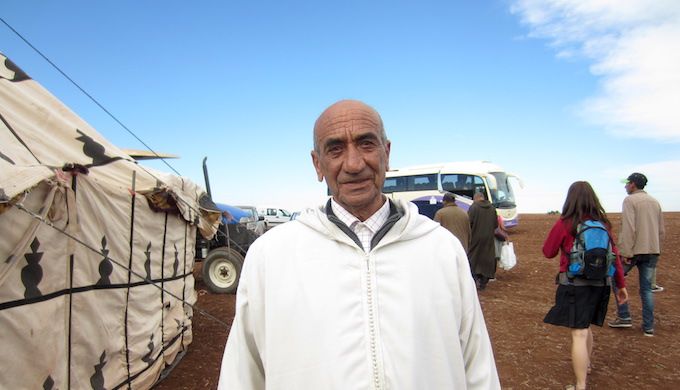An alternative farming method of direct seeding that helps Moroccan farmers use water optimally is seen as a good way to cope with weather changes due to climate change

Moroccan farmer Bil Hassan of Settat lauds the new method of cultivation. (Photo by Keya Acharya)
At some 170 km north of Marrakesh in Morocco, the drive to Settat is stark in its arid scenery of depleted soils and eroded lands with deep rills showing up where rainfall runs off. Here and there, there are brave attempts at planting olive trees, though the rows of newly planted cactus look in better health.
At intervals on the road and much like elsewhere in Africa, there are boxes in steps going from the ground to about the fourth level, meant for displaying fruits and vegetables for sale. Almost all of them were empty, barring a few where farmers held up country chickens for sale to passing cars.
When you arrive at Settat, there is hardly a tree in sight, but the soil looks amazingly soft and friable for so arid an area. What is also interesting is that Settat’s soft, moist-looking soils will be of particular interest to India and any nation in the world facing both climate change and arid soils.
No tilling
Settat’s 350 farms use a method called direct seeding, also known as no till. The land is not raked up as in conventional systems, but a truck with a rake-like tool at the rear, pulls a soft line in the soil with small indentations at 10cm intervals to place one seed along with fertiliser. The line is not more than 8-10cm deep.
Agricultural scientist Ousama El Gharras from Morocco’s National Institute of Agricultural Research, Settat, says the most dramatic evidence of climate change in Morocco is in its depleting rainfall. In Settat, rainfall has reduced from 500mm a year to 300mm. Groundwater percolation is poor in the country, while irrigation happens in just 10% of Morocco’s 18m ha of arable lands, yet agriculture constitutes 16-20% of the country’s gross domestic product.
Farmers, traditionally growing barley and wheat on these rain-fed soils at Settat are now happy with the results from direct seeding. Farmer Bil-Hassan, in a striking white lambs wool djellaba, the traditional overall for men, says he now gets 900 quintals of wheat per hectare where in recent previous years he got hardly anything.
“We trained the farmers in direct seeding methods”, says Gharras. “The machines are expensive, but can be rented by farmers for operations.” Gharras also says that banding the farmers together into associations with the help of NGOs has been of great benefit to them. Traditionally, Moroccan farmers worked alone, thus being more vulnerable.
Ninety-nine per cent of the farmers are men. Director of Agriculture at Settat, Saad Zaghloul Hassan of the Moroccan government says women help indirectly in the farms and have also benefited from the system.
The Global Environment Facility (GEF) had given a grant of USD 4.3 million for introducing direct seeding on 500 ha in the Settat region. The machines are mostly from the US, but technology has also been imparted from Brazil, Australia, Spain and others, says Gharras.
Better use of water
No-till soil use less water while retaining moisture longer than conventional tilling where soils get compacted faster due to larger exposure to rain, wind and seasons. Crop residues are left to leach its nutrients into the soils, while plants themselves do well in smaller areas exposed to wind and evaporation. The farms need less equipment and fewer tending-trips and topsoil loss is also stemmed due a smaller area’s vulnerability to wind erosion.
The GEF’s project has been so successful that the government of Morocco has incorporated the system as a tool for climate change adaptation in their country plans, instituting subsidy for farmers practising the method.
The GEF funding has now stopped, but Gharras says he is convinced the farmers won’t fall back into old ways because they have seen for themselves the benefits reaped in the past five years from this method. “When you show it to them live in the fields, farmers get convinced,” he says.
India, where over 60% of its farmers are smallholders, has some discrete areas scattered around the country where individual farmers are practising no-till agriculture along with organic fertilisers and pesticides. Though reports from all such farms note increased productivity and health of soils, India has yet to officially incorporate the system as official policy.
